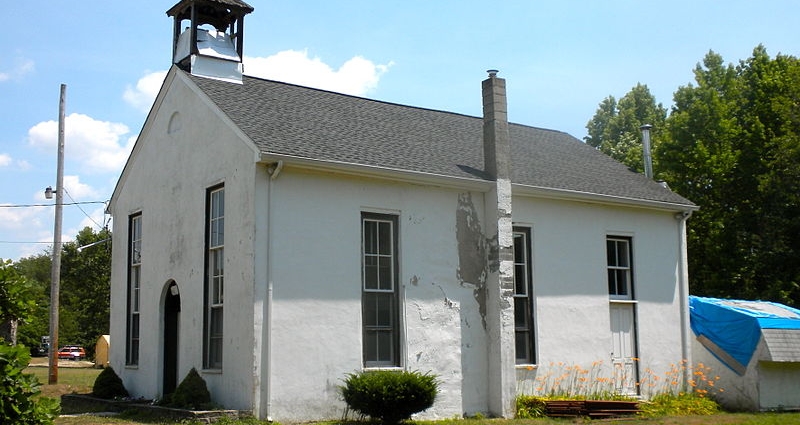Municipality: Greenwich
Category: Church, African Methodist Episcopal
Springtown, one of the oldest black settlements in Cumberland County, is located about a mile from the colonial village of Greenwich. The Springtown Bethel African Methodist Episcopal Church was built between 1838 and 1841, and marked a growing community.
Springtown gradually developed after the Manumission Act of 1786, when Quakers sold small tracts of land to free blacks who built homes and began to raise families. While slavery did exist during the 18th century in Cumberland County, the number of slaves was very low and by 1804 New Jersey’s Gradual Abolition of Slavery Act began the end of slavery in the state. In the 1800 Census, there were approximately seventy-eight free people of African descent in Greenwich Township in addition to an equal number of slaves. The last slave in Greenwich was released from bondage in 1829.
Early members of Methodist Episcopal churches were strongly opposed to slavery and until the early 1800’s black and white Methodists in southern New Jersey worshipped together. However, when Methodist membership grew to include more slaveholders, church leaders softened their opposition to slavery. A separate but not equal relationship soon formed in the white Methodist churches, and African American members began to organize their own churches. In 1810, the local black members of the Methodist congregation purchased a structure to use as a church of their own. In 1824, this congregation of African Methodist Episcopal members numbered thirty-eight individuals. This original church was destroyed by fire in the late 1830’s, and the congregants met at the Hicksite Quaker Meeting House down the road until the present A.M.E. church was built between 1838 and 1841.
By the time the current Bethel A.M.E. Church was built, Springtown was a thriving community. Tax records from 1837 showed fifty-one African American households in Greenwich and the community supported not only the thriving Bethel A.M.E. Church, but also a Wesley Methodist Church built in 1832 and an African Union Church built in 1850, neither of which exist today.
Springtown and its Bethel A.M.E. Church were involved in the Underground Railroad and included several members who led the Abolitionist movement in the 19th century. The community was an important destination for fugitive slaves leaving Delaware and the eastern shore of Maryland. Greenwich and Springtown were perfected located geographically for this purpose as they are were settled on a peninsula between the Cohansey River and the Delaware Bay providing numerous routes by water for incoming runaway slaves. For some it was a temporary destination before moving on while for others it was the end of their running, and their presence swelled the size of Springtown and strengthened it as a force for abolition.
The Underground Railroad was a network of secret routes and safe houses used by 19th century black slaves to escape from the South to northern free states and Canada. The escape network was not literally underground nor a railroad. It was figuratively “underground” in the sense of being an underground resistance. It was known as a “railroad” by way of the use of rail terminology as secret code words. Leaders of the effort were known as “conductors” and the various routes to freedom were known as “lines”. The Greenwich line was described at the time as “a circle of Quaker residences” surrounding the low-lying heavily wooded area of Springtown.
The passage of the Fugitive Slave Act of 1850 by Congress created a growing threat to the liberty of every person of African descent in Springtown and throughout the nation. The Act declared that all runaway slaves be returned to their masters and was referred to as the “Bloodhound Law” by abolitionists for the dogs that were used to track down runaway slaves. Luckily, Springtown was heavily wooded and the Bethel A.M.E. Church was built along a small tributary of the Cohansey River known as Molly Wheaton Run which formed a swampy expanse behind the church in which runaway slaves could hide when slave-catchers were in the area.
Several members of the Bethel A.M.E. congregation were Underground Railroad Operators and one of the most noted Underground Railroad leaders, Harriet Tubman, is said to have lived in and worked out of Springtown for a time between 1849 and 1852. Another important participant in the efforts of the Underground Railroad in the area were the Lenape Indians. The Lenape knew the tides, currents and every inlet in and around Greenwich, and often traveled to Delaware by boat to visit relatives.
When the Civil War erupted in 1861, African American men from Springtown and Bethel A.M.E. Church enlisted in the United States Colored Troop regiment and fought and died to finally end slavery in the United States.
Springtown had its largest population after the Civil War until about 1890. Gradually, the population of Springtown declined as families moved to larger industrial cities for social, economic and educational advantages. In the 1880’s, Springtown was a thriving village with over eighty households, three churches and a school that closed in 1950.
The church itself is built of New Jersey sandstone covered with a mortar parge – a thin coat of mortar. The belfry was added in 1885. By the 1990’s the church had declined to only four members. Concerned that the history of Springtown and the Bethel A.M.E. Church would be lost, an effort was made to begin to stabilize and restore the church. In 1999, Bethel A.M.E. Church was listed on the National Register of Historic Places and the preservation of the church continues.

